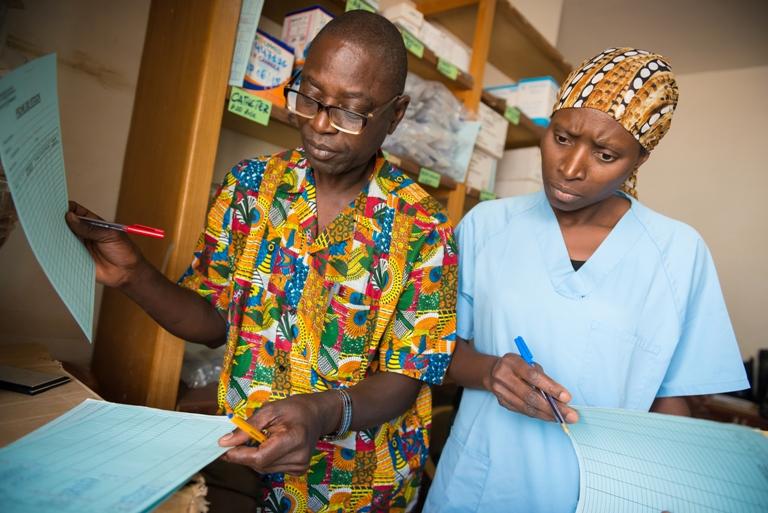Where We Work
See our interactive map


The Informed Push Model—a public-private partnership model ensuring contraceptive security in Senegal—has received a lot of attention in the last few years. IPM, as the model is known, reduces stockouts and is one component of Senegal’s successful progress in family planning over the last few years.
But what is IPM? Simply put, it’s a way of managing the supply chain of contraceptives so women can reliably go to their health centers and leave with the family planning methods they want—not empty-handed or with a second- or third-choice method they are less likely to use.
Logistics seem simple. Deliver contraceptives from the regional supply pharmacy to the clinics that need them. In fact, it seems so simple that national supply chains had been largely ignored in health development programs until the last decade or so.
But the private sector has long recognized the complexity and value of supply chain management. Talk to Coca-Cola or Nokia. Their investments in supply chain logistics are exactly why we see photos of people in even the most remote locations drinking Coke or using cell phones.
In the Dakar, Ziguinchor, and Kolda regions of Senegal, we’ve partnered with a private-sector distribution company, Don Bosco, since 2012 to tackle this “simple” problem of logistics as part of the Expanding the Informed Push Model for Family Planning in Senegal project. We sat down with Jean Pierre Kandety, president of the IEG Don Bosco, to learn more about how the supply chain works.
What does it take to supply contraceptives to a health center?
Kandety explained that Don Bosco employs a team responsible for collecting data and delivering products, including an IT technician, four drivers, and eight operators throughout the three regions it covers. The company collects products from the regional supply pharmacy and stores them in its warehouses (which all must adhere to National Supply Pharmacy standards). Teams then distribute the products to service delivery points (logistics-speak for health centers and outposts).
Upon arrival at a service delivery point, the Don Bosco operator meets with the health center manager, carries out an inventory to see what’s in stock in the pharmacy, and records the inventory data using a template. Next, the operator fills out a delivery slip that must be signed by the pharmacy staff, the health center manager, and the Don Bosco operator. The company leaves one delivery slip at the service delivery point, submits another to IPM project staff, and sends a third to an assistant logistics provider for the region.
After each trip, the operator draws up a report of stock inventories and sends it to the assistant logistics provider. A software application called Comtract has made this process easier. The assistant logistics provider checks the data against regional average monthly consumption rates of products, and places the next order.It all comes down to collecting and using data to project product demand and order and deliver supplies before a health center runs out.
What challenges remain?
IPM has been very successful, reducing stockout rates to as low as 2%in some regions. But that doesn’t mean challenges have disappeared or that stock-outs never happen. For example, at the time of the interview, Don Bosco had been out of Norlevo for three months. Kandety says this is a big challenge, particularly when health workers and women have come to rely on consistent supplies.
The other main difficulty is the remote and difficult terrain operators must cross to reach certain health outposts. Don Bosco has often spent more time and resources than anticipated on transportation and vehicle maintenance to keep supplies flowing.
For example, it can take two to three hours to reach some of the outposts in Kolda and Ziguinchor. And the island of Niomoul in Ziguinchor presents its own challenges. The health outpost there is about 1 mile (1.5 km) from the embankment. “To get there, you have to take your shoes off to avoid falling, because of the furrows,” Kandety says. “Then you sling the products over your shoulder and carry them to the health outpost.”
Kandety understands the big picture of how his company contributes to improving health in Senegal and the valuable role partnership plays.
“We sense the impact of our work through the conversations we have with local partners,” he says. “Today, IPM allows a significant proportion of the population to benefit from a service which is, in reality, a right. The state, NGOs, and those of us in the private sector must strive to sustain our activities. That can only be possible if we all pull together.”
This post originally appeared on the K4Health blog.
IntraHealth’s work in Senegal with the Informed Push Model is funded by the Bill & Melinda Gates Foundation and Merck for Mothers. Photograph courtesy of IntraHealth International.
Get the latest updates from the blog and eNews




